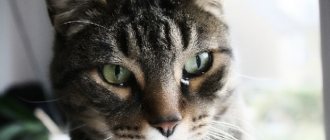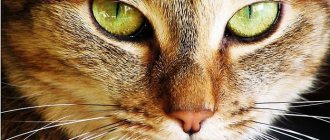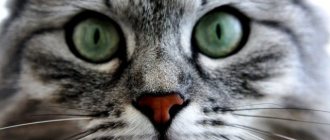In the material we covered the topic of cat vision, its characteristics, the ability of cats to distinguish colors and see the world around them. There are many myths and fairy tales surrounding these animals, but what is true? How does your pet really see the world? In this article you will learn the answers to these questions, and also understand how to recognize your pet’s vision problems and how to help your pet if the symptoms are confirmed.
Connection with the other world
There are many myths and legends around cats. The ancient Egyptians worshiped these beautiful creatures and believed that they had a clear connection with the other world, namely they could see spirits and the afterlife. Of course, from confirmation, we only have incredible stories of lovers of these animals, or, from close ones, the story of a neighbor, Aunt Lucy, who claims that her cat hisses into the void, and precisely at the moment when inexplicable rustlings are heard in the corridor.
In general, there is a rational explanation for this behavior; cats can really see what we humans cannot. In 2014, studies were conducted that showed that their eyes have ultraviolet vision, which confirms that they actually notice things that our human vision is not given.
In fact, our pets initially see the world differently, and this is due to many factors, from the structure of the eye to color rendition. What kind of vision do cats have?
Vision in cats
Let's summarize what kind of vision a cat has. Despite the fact that the structure of the eyeball is similar to that of humans, the cones and rods of the cat family are much more sensitive. They do not need a large amount of light, so they react to any movements even in the dark. The peculiarities of cats' vision include the fact that they do not see an object in the smallest detail, but only its silhouette. But for any predator hunting from an ambush, this is enough to catch its prey.
To understand what type of vision a cat has during the daytime, you should know that in bright light, its pupils constrict in order to regulate the flow of light particles. Because of this, in daylight, a cat’s eyes see a little worse than in evening light. But she is able to see with her own eyes infrared radiation, which is inherent in all living beings.
The features of binocular vision include a wide coverage of the surrounding world, and it is this type of vision that is developed in cats. They see, unlike other animals, 270 degrees around, which is much wider than that of humans. But in this regard, cats are worse at recording vertical movement, but they see horizontal movements of prey perfectly. This is probably due to the fact that they catch flying animals less often.
At night, cats see better than during the day due to the fact that their sensitivity to light is too strong. This is precisely why cats like to sleep during the day and hunt at night.
What are the characteristics of a cat's vision?
Let's start with the structural features. The very first difference is the large size of the eyes, and if you look at their scale relative to the size of the body and head, then the Cat's eyes are simply huge. Cats are the only domestic animals with such eyeballs. Associated with this feature is another important one – viewing angle. In cats it is up to 270°, while in humans it is only 180°.
Cats' eyes are set deeper in the skull than humans, so they are better protected. Also, for additional protection, cats have a third eyelid, which is closely adjacent to the membrane of the eye in its inner corner; it also helps the movement of tear fluid through the eye. This eyelid can be seen when a cat is dozing with her eyes slightly open. We also note the peculiarity of the location of the eyes: they are directed forward (unlike their victims) and are located close to each other.
Cat's eye in profile.
The picture that the cat perceives with its right and left eyes are combined and this allows it to form a general, three-dimensional image. Cats have binocular vision, meaning they see everything in 3D, just like humans. Thanks to this, cats are able to accurately determine the shape, size of an object, location and distance to it, which is especially important during hunting.
The significant superiority of cats over humans is visual acuity, which is almost 3 times higher than that of humans. Cats perceive up to 50 frames per second, while we perceive only 24 frames, so cats are better able to distinguish objects that are in motion, especially in the horizontal direction, but it is much more difficult for cats to recognize movement in the vertical direction. This feature is due more to evolution; mainly the prey that felines hunt move along a plane.
On a bright sunny day, cats' pupils are usually constricted into thin vertical lines to reduce stress on the sensitive retina by reducing light output. Seeing perfectly in the evening, cats see much worse during the day, which is why many of the Murziks and Muroks prefer a daytime siesta and evening promenades (i.e., sleeping off during the day in order to stay awake at night).
Cat pupils in bright light.
Features of vision of cats
Cats have disproportionately large eyes in relation to the size of their heads. The pupils of these huge eyes are capable of expanding to their maximum limits. Many could observe how, at dusk, “dark holes” appear in a cat’s eyes instead of eyes - the pupils become enormous in order to let in as much light as possible.
All animals, including humans, have two types of light-sensitive cells in the retina of the eye - rods and cones. Rods are extremely photosensitive and are capable of capturing even one photon - an elementary particle of light! This applies to everyone, but cats have many more rods in their retinas than many other animals. For example, if in humans 4 out of 5 light-sensitive cells in the retina are rods, then in cats, respectively, 25 out of 26 cells are.
In cats, as in some other animals, such as raccoons and deer, there is a tapetum, an organ that functions as a mirror, located behind the retina. By reflecting the light, it redirects it to the retina, where the rods capture it with renewed vigor.
A cat also has vibrissae - and this is also a kind of “visual organ” capable of detecting the slightest changes in the surrounding space. These are the “miracles” that give cats the truly impressive ability to see at dusk.
How far can they see?
Cats are farsighted creatures. They can examine in detail an object that is located at a sufficient distance from them (from 0.75 meters to 6 meters), the maximum distance is 60 meters, but cats see everything that is nearby blurry.
“Cats don't have the muscles needed to change the shape of their eye lenses, so they can't see as clearly as close as humans and need to move away from objects,” says Ketring. “And although your pet may be excellent at catching mice scurrying in fear, many slow-moving objects visible to the human eye appear motionless to cats.” To explore objects that are too close, the cat resorts to other senses, which are also well developed - smell and touch.
A good example: how a person sees, and how a cat sees the same picture.
What colors do cats see?
For a long time it was believed that purrs had monochrome vision (a congenital disease characterized by complete color blindness), but in the last century scientists finally proved that this is not so; cats have color vision. Of course, a cat’s color perception is much worse than a person’s, but still the world plays with different colors for it.
The color range they distinguish is: black, white, blue, green, yellow, and gray occupies a very important place. Murks can distinguish up to 26 of its shades (this is also due to evolution, since almost all animals that felines hunt are gray in color colors).
Do cats see colors?
This problem has long worried humanity; for a long time the vision of wild and domestic cats was considered monochrome - black and white.
The exact answer to the question was given only in the middle of the 20th century. It has now been reliably proven that a cat’s eye is capable of distinguishing the slightest shades of gray – up to 26 shades. The animal perceives “cold” shades best.
Gray is the most important color for our pets. This is the color of rats, mice, and some birds, which this predator feeds on in nature.
In addition, the cat distinguishes colors: blue, green, purple and yellow. The animal may confuse the last two colors with white.
So, the cat distinguishes colors:
- black;
- gray (with all shades);
- white;
- green;
- blue;
- blue.
Red, brown, orange shades are completely inaccessible to the pet's eye. Also, multi-colored combinations are not perceived.
What colors does a cat not distinguish at all?
But cat’s eyes are not able to perceive this range of colors: red, brown, multi-colored combinations. Since the brightness of the images is greatly reduced, a cat may often confuse white with yellow, or almost black with orange or red.
If you have a question, why then do cats run after the red dot from the laser? In fact, the color scheme does not matter to cats; their attention is attracted precisely by the fact that the point is in motion.
Cats and evil spirits - features of relationships
It is no coincidence that fluffies are called “empty residents.” They really often “hang” at the junction of two rooms, two worlds. Watch your four-legged friend: his favorite place will be either a window sill or a doorway. Having taken their post, purrs can stare at one point for hours; even the owner’s voice does not always bring them out of their trance. So what do cats see that we don’t?
The three worlds - Reality, Nav, Rule - for humans are separated by a rather dense veil, which only a select few are able to consciously penetrate. People live in the real dimension, navigating through the five senses. True, there is also clairvoyance, clairaudience, telepathy and genetic memory, but most homo sapiens, if they had them, have long since atrophied as unnecessary. With animals it’s the other way around—to survive, they needed to develop all their hidden abilities.
A person is forced to learn everything he knows, starting with speech and walking upright, and kittens “inherit” most of the skills. For example, even when separated from their mother in infancy, they can “rattle” - make special vibrating sounds needed to communicate with people (this method of “negotiation” is not used within the cat population).
Brownies
Most owners are sure that cats see brownies, but recognize their right to be in the room, since they do not feel danger - therefore they calmly react to strange sounds, creaks and rustles that frighten the owners.
Ghosts
But ghosts and other inhabitants of another world have no place among people, so their appearance can provoke cat aggression.
- If the cat behaves inappropriately, hisses for no reason, raises its fur on end, hides or attacks something invisible, it probably sensed an uninvited guest and is trying to drive it away. In such a situation, you will immediately understand that the pet is scared.
What to do in such a situation? Let the cat deal with the uninvited guest on his own. He will fight for his territory to the last, and in such fights it is usually the mustachioed owners who win. If your pet's behavior has become too aggressive and unpredictable, temporarily move it to another home.
How do cats see in the dark?
Animals see due to the fact that light, passing into the eye, irritates the nerve endings of the retina, then these irritations are transmitted along the fibers of the optic nerve to the brain and appear in the head in the form of a “picture” that we see. This information mainly refutes the myth that cats can see perfectly in pitch darkness.
Our favorites are more crepuscular animals, their vision is tuned to perceive dimly lit space (this is especially important for hunting). With very poor lighting, a cat receives significantly more visual information compared to a human. A cat can distinguish objects and other animals in light less than 20% of the amount of light required by the human eye.
Here you can also pay attention to the retina of the eye, covered at the back with tapeum; it works like a mirror - it reflects the light that hits it onto the photoreceptors. As a result, the cat's eyes begin to glow. All nocturnal predators have this substance. Thanks to this feature, our pets see better in the dark.
The most important myth is that cats see in complete darkness.
What is the difference between how we see and how they see?
Every person has seen the glow of a cat's eyes, be it in a photograph or just in a dark room. This phenomenon is explained by the fact that behind the retina there is another light-reflecting layer - the tapetum. It is thanks to him that cats are many times more photosensitive than humans. Did you know that by the glow of a cat's eyes you can determine the color of their iris? As a rule, a red glow is observed in purrs with blue eyes, and a green glow is observed in yellow-eyed ones. Thanks to this structure of the visual organ, cats see perfectly in a dimly lit room, but in an environment with bright light, human vision is superior to that of a cat.
This is roughly what cats see in the dark at night.
We have often heard that cats can see in pitch darkness, but this is not true. This misconception arose because they have a well-developed sense of smell, thanks to the vibrissae, which are popularly called cat whiskers. Therefore, even in absolute darkness, Murchiki bypass any obstacles.
However, their vision is somewhat similar to ours. For example, binocularity, that is, the picture that one eye of a cat sees overlaps with the one seen by the other, then they are added into one. This feature distinguishes cats from those animals that have monocular vision and see two different pictures. To our great regret, the mustachios have another interesting advantage - their viewing radius is 200 greater than ours.
Cats are predators, and they hunt from ambush, so with great speed and clarity they determine the speed and trajectory of their prey. In this regard, purring hunters are better able to distinguish objects that move, especially in the horizontal plane.
The structure of a cat's eye
And how can one not note the amazing structure of the cat’s pupil? Unlike humans, in cats it has a slit-like shape, although in a dark environment it can become oval or round. In bright light, it contracts as much as possible, protecting the cat’s sensitive retina from damage. And in the dark, the pupil, on the contrary, expands as much as possible in order to ensure the absorption of the slightest rays of light.
The Adobe Flash Player is required for video playback.Get the latest Flash Player or Watch this video on YouTube.
How does a cat see a person?
If we pay attention to all the facts that we have listed, we will understand that our pet sees us almost as we are, except that the colors are slightly different and the figure is more blurred. And if we are in close proximity to them, then the animal will definitely not distinguish facial features. Since most often we are at a minimum distance from our pet, it is unlikely that he knows what kind of nose or lips you have, it doesn’t matter to him at all. The smell of a beloved owner is much more important; his animals will definitely not confuse him with anyone else.
Do they see the image on TV and their reflection in the mirror?
Scientists have different opinions on this question; some argue that cats only see flickering, because... vision in good light is inferior to night vision. Others note that cats can purposefully look at the TV screen and observe what is happening. However, if the Murks see what is happening on the screen, then for them it is more of an alternating change of pictures, like a slide show (I remind you about the perception of 50 frames per second).
But they perceive their reflection in the mirror well, it’s just that this picture does not arouse much interest in them, since they cannot perceive it with other senses, that is, they cannot smell it.
Vision problems
The eyes of a cat are not only the dignity and decoration of this beautiful animal, but also one of the weakest points. Very often, pets develop diseases that put the clarity and health of their vision at risk. Some of the most common eye diseases that occur in cats include conjunctivitis, cataracts, glaucoma, keratitis, sequestration (necrosis) and epiphora. Any alarming symptoms (for example: lacrimation, squinting of one or both eyes, redness, discharge of pus, photophobia, change in the color of the iris, etc.) is a reason to consult a doctor, preferably a specialist - a veterinary ophthalmologist.
Watery eyes and other problems
It is important to know that diseases that affect the eyes of cats can be not only ocular, but also systemic. A number of infectious diseases occur with purulent discharge from the eyes.
Let's look at the main causes and diseases that lead to excessive tearing:
- Conjunctivitis. It is an inflammation of the inner mucous membrane of the eye and is accompanied, in addition to lacrimation, by redness and swelling. The animal often rubs its eyes, blinks and squints. After sleep, the eyelids stick together. In most cases, conjunctivitis can be a manifestation of some serious disease.
- Activity of parasites. Neglecting anthelmintic treatment can lead to your pet becoming infected with worms. In this case, there is usually swelling of only one eye and profuse lacrimation.
- Keratitis. If the eyes are covered with a cloudy film, redness and discharge are observed, then most likely the cornea is inflamed. Trauma or infection can lead to the development of this disease.
- Blepharitis. The primary symptoms of the disease include inflammation of the eyelids, itching and redness. In the absence of therapy, profuse lacrimation begins, crusts and swellings form. This pathology is often confused with conjunctivitis; a specialist can make the correct diagnosis.
- Allergy. In addition to lacrimation, reactions to external irritants can include itching, rash, sneezing, shortness of breath and even vomiting.
- Infectious diseases. Chlamydia or calcivirus can cause lacrimation. The first disease is also accompanied by fever, nasal discharge, and cough. Calcivirosis is characterized by fever, lethargy, lack of appetite, inflammation of the gums, and sometimes lameness develops.
- Respiratory diseases. Watery eyes may be a consequence of a cold. In this case, it is accompanied by sneezing, coughing and fever.
- Injuries and foreign objects. Street travel and fights can cause damage to a cat's eyes or a foreign object getting into them. In addition to copious tears, injury is accompanied by swelling, redness, and clouding of the eye. If the injury is serious, the animal meows in pain and constantly rubs the problem area. In addition to tears, pus or blood may flow from the animal's eyes.
- Congenital structural anomalies. The incorrect structure of the eyelid, when it either turns strongly inward and irritates the conjunctiva, or, conversely, turns outward, opening access to dirt and external irritants, leads to lacrimation.
- Glaucoma. When intraocular pressure increases, in addition to discharge, redness and clouding of the lens are observed.
- Cataract. This is a fairly rare disease in cats. Its development is typical for older animals. Cataracts are incurable, but if detected at an early stage, it is possible to significantly slow down the clouding process.
An example of conjunctivitis in an animal.
How to notice the symptoms?
If there are changes in your pet's behavior:
- rubs eyes with paw ·
- blinks frequently
- avoids bright light
- squints
Symptoms in eye condition: ·
- accumulation of pus in the corners of the eyes
- lacrimation ·
- swelling of the eyelids
- redness ·
- cloudiness of the eyeball
To detect these symptoms, be more attentive to your pet and periodically conduct self-examination. If, during the next examination of your cat's eyes, you notice alarming symptoms, then wipe your eyes with a damp cloth and observe how soon the discharge appears. If your fears are confirmed, then, of course, you need to see a doctor, no home self-medication, this can lead to even more complex consequences!
Healthy eyes, in normal lighting.
Features of cat vision
Cats are nocturnal animals. They see at night 6 times better than us. This opportunity is given to them by a “mirror” located on the wall of the retina. The light absorbed by the pupil, which is significantly dilated at night, hits the “mirror” and is reflected and transmitted to the nerve fibers. This is how cats get a high-quality night picture. It is because of these reflective abilities that the animal's eyes glow in night photographs. A person does not have such an opportunity, but during the day we see better. Since daylight is bright, the predator’s pupil turns into a narrow strip so as not to damage the sensitive retina and the animal distinguishes objects blurry.
The vision features of cats have always attracted attention. Not only from a scientific point of view. Their ability to see what is invisible to us has created many myths, legends, and horror stories, which we will discuss below.
Despite this, in Rus' these animals were considered an expensive gift: cats saved the harvest from rodents, served as a symbol of well-being, and protected the house from otherworldly forces. They became the heroes of many fairy tales, nursery rhymes and proverbs.
The cat's organ of vision differs sharply from the human one in structure and ability to perceive space. They have large, round eyes with a convex lens. The viewing angle of space is 270 degrees.
A special feature of cats is stereoscopic vision. Each eye receives its own image of an object, which is then combined by the brain into one three-dimensional picture. As a result, the predator receives accurate information about the location of the prey and the distance to it.
Everything that the left eye sees goes to the right side of the brain and, conversely, the right eye transmits the picture to the left half
The genetic memory of a predator makes animals react to moving objects. Stationary animals are practically of no interest to them. Watching a moving object, the animal begins to actively move its head up and down: this is how the cat changes its viewing angle and focuses on the prey. This natural ability helps the predator calculate the distance to the prey down to the millimeter, which is why the cat’s jump is so accurate.
The special sensitivity of a cat's eyes is directly related to the structure of the pupil. It is located vertically and has increased elasticity. In bright light, it narrows, limiting rays from reaching the retina. Lack of lighting causes the pupil to dilate greatly, allowing more light to enter.
Cats suffer from various vision disorders quite often. The owner should be wary if the animal hides its eyes from bright light or often rubs its face with its paws. Signs of inflammation are frequent blinking of the pet, pus in the corners of the eyes, clouding of the whites, swelling of the eyelids. Any of these signs is a reason to immediately consult a veterinarian.
Kittens that are blind at an early age have much longer whiskers than their kittens. This is how nature compensates for the lack of visual perception of the world
Some eye diseases can cause complete blindness in your pet. It is difficult to notice vision problems in cats in order to take timely measures, since they are able to navigate in space even with complete blindness. The following signs indicate that vision problems have begun and should be checked:
- the animal does not jump to its favorite places located at a height or, when jumping, misses and falls;
- when moving around the house, he comes across moved or new furniture, objects standing in unusual places;
- your pet’s pupils do not constrict in bright light;
- stops responding to favorite toys;
- when the pet looks at the owner, his gaze does not focus on him.
All these signs indicate a deterioration in the cat’s vision or the onset of blindness.
Unfortunately, it is not always possible to restore a pet’s vision, but this is not a reason to abandon a sick animal. The owner should organize the space of the home in such a way that the animal feels comfortable. Your pet can live a full life if you do the following:
- do not change the location of bowls with food and water;
- do not let the animal out into the street unattended, take it for a walk on a leash;
- in a new room, accustom the cat to the location of objects, without frightening them and allowing them to find their own way;
- do not block the path with boxes, scattered toys and other objects.
What to do if your cat begins to see poorly?
If you notice that your cat has begun to navigate space differently, then pay attention to the following points in its behavior: The cat refuses to jump or does it awkwardly. The cat comes across objects that are in a new place for it. The cat looks past you. The cat's pupils are statically dilated. Do any of the points apply? Then remember that you should not let a cat with poor vision out of the house, it is also not advisable to rearrange the furniture and remove bowls of water and food from its usual place, because the cat knows where everything is and can perfectly navigate in space blindly, including others, well developed sense organs.
It has been proven that the longer a cat's whiskers, the worse her eyesight.











